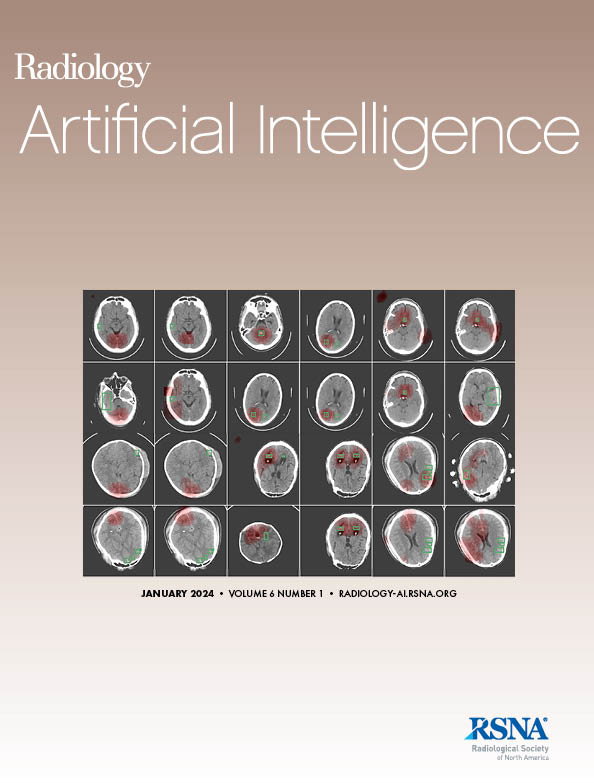Vision Transformer-based Decision Support for Neurosurgical Intervention in Acute Traumatic Brain Injury: Automated Surgical Intervention Support Tool.
IF 8.1
Q1 COMPUTER SCIENCE, ARTIFICIAL INTELLIGENCE
Christopher W Smith, Armaan K Malhotra, Christopher Hammill, Derek Beaton, Erin M Harrington, Yingshi He, Husain Shakil, Amanda McFarlan, Blair Jones, Hui Ming Lin, François Mathieu, Avery B Nathens, Alun D Ackery, Garrick Mok, Muhammad Mamdani, Shobhit Mathur, Jefferson R Wilson, Robert Moreland, Errol Colak, Christopher D Witiw
下载PDF
{"title":"Vision Transformer-based Decision Support for Neurosurgical Intervention in Acute Traumatic Brain Injury: Automated Surgical Intervention Support Tool.","authors":"Christopher W Smith, Armaan K Malhotra, Christopher Hammill, Derek Beaton, Erin M Harrington, Yingshi He, Husain Shakil, Amanda McFarlan, Blair Jones, Hui Ming Lin, François Mathieu, Avery B Nathens, Alun D Ackery, Garrick Mok, Muhammad Mamdani, Shobhit Mathur, Jefferson R Wilson, Robert Moreland, Errol Colak, Christopher D Witiw","doi":"10.1148/ryai.230088","DOIUrl":null,"url":null,"abstract":"<p><p>Purpose To develop an automated triage tool to predict neurosurgical intervention for patients with traumatic brain injury (TBI). Materials and Methods A provincial trauma registry was reviewed to retrospectively identify patients with TBI from 2005 to 2022 treated at a specialized Canadian trauma center. Model training, validation, and testing were performed using head CT scans with binary reference standard patient-level labels corresponding to whether the patient received neurosurgical intervention. Performance and accuracy of the model, the Automated Surgical Intervention Support Tool for TBI (ASIST-TBI), were also assessed using a held-out consecutive test set of all patients with TBI presenting to the center between March 2021 and September 2022. Results Head CT scans from 2806 patients with TBI (mean age, 57 years ± 22 [SD]; 1955 [70%] men) were acquired between 2005 and 2021 and used for training, validation, and testing. Consecutive scans from an additional 612 patients (mean age, 61 years ± 22; 443 [72%] men) were used to assess the performance of ASIST-TBI. There was accurate prediction of neurosurgical intervention with an area under the receiver operating characteristic curve (AUC) of 0.92 (95% CI: 0.88, 0.94), accuracy of 87% (491 of 562), sensitivity of 87% (196 of 225), and specificity of 88% (295 of 337) on the test dataset. Performance on the held-out test dataset remained robust with an AUC of 0.89 (95% CI: 0.85, 0.91), accuracy of 84% (517 of 612), sensitivity of 85% (199 of 235), and specificity of 84% (318 of 377). Conclusion A novel deep learning model was developed that could accurately predict the requirement for neurosurgical intervention using acute TBI CT scans. <b>Keywords:</b> CT, Brain/Brain Stem, Surgery, Trauma, Prognosis, Classification, Application Domain, Traumatic Brain Injury, Triage, Machine Learning, Decision Support <i>Supplemental material is available for this article.</i> © RSNA, 2024 See also commentary by Haller in this issue.</p>","PeriodicalId":29787,"journal":{"name":"Radiology-Artificial Intelligence","volume":" ","pages":"e230088"},"PeriodicalIF":8.1000,"publicationDate":"2024-03-01","publicationTypes":"Journal Article","fieldsOfStudy":null,"isOpenAccess":false,"openAccessPdf":"https://www.ncbi.nlm.nih.gov/pmc/articles/PMC10982820/pdf/","citationCount":"0","resultStr":null,"platform":"Semanticscholar","paperid":null,"PeriodicalName":"Radiology-Artificial Intelligence","FirstCategoryId":"1085","ListUrlMain":"https://doi.org/10.1148/ryai.230088","RegionNum":0,"RegionCategory":null,"ArticlePicture":[],"TitleCN":null,"AbstractTextCN":null,"PMCID":null,"EPubDate":"","PubModel":"","JCR":"Q1","JCRName":"COMPUTER SCIENCE, ARTIFICIAL INTELLIGENCE","Score":null,"Total":0}
引用次数: 0
引用
批量引用
Abstract
Purpose To develop an automated triage tool to predict neurosurgical intervention for patients with traumatic brain injury (TBI). Materials and Methods A provincial trauma registry was reviewed to retrospectively identify patients with TBI from 2005 to 2022 treated at a specialized Canadian trauma center. Model training, validation, and testing were performed using head CT scans with binary reference standard patient-level labels corresponding to whether the patient received neurosurgical intervention. Performance and accuracy of the model, the Automated Surgical Intervention Support Tool for TBI (ASIST-TBI), were also assessed using a held-out consecutive test set of all patients with TBI presenting to the center between March 2021 and September 2022. Results Head CT scans from 2806 patients with TBI (mean age, 57 years ± 22 [SD]; 1955 [70%] men) were acquired between 2005 and 2021 and used for training, validation, and testing. Consecutive scans from an additional 612 patients (mean age, 61 years ± 22; 443 [72%] men) were used to assess the performance of ASIST-TBI. There was accurate prediction of neurosurgical intervention with an area under the receiver operating characteristic curve (AUC) of 0.92 (95% CI: 0.88, 0.94), accuracy of 87% (491 of 562), sensitivity of 87% (196 of 225), and specificity of 88% (295 of 337) on the test dataset. Performance on the held-out test dataset remained robust with an AUC of 0.89 (95% CI: 0.85, 0.91), accuracy of 84% (517 of 612), sensitivity of 85% (199 of 235), and specificity of 84% (318 of 377). Conclusion A novel deep learning model was developed that could accurately predict the requirement for neurosurgical intervention using acute TBI CT scans. Keywords: CT, Brain/Brain Stem, Surgery, Trauma, Prognosis, Classification, Application Domain, Traumatic Brain Injury, Triage, Machine Learning, Decision Support Supplemental material is available for this article. © RSNA, 2024 See also commentary by Haller in this issue.
基于视觉转换器的急性创伤性脑损伤神经外科干预决策支持:自动外科干预支持工具 (ASIST-TBI)。
"刚刚接受 "的论文经过同行评审,已被接受在《放射学》上发表:人工智能》上发表。这篇文章在以最终版本发表之前,还将经过校对、排版和校对审核。请注意,在制作最终校对稿的过程中,可能会发现影响文章内容的错误。目的 开发一种自动分诊工具,在不使用图像级标签的情况下预测创伤性脑损伤(TBI)患者的神经外科干预情况。材料和方法 对省级创伤登记进行审查,以回顾性地识别 2005-2022 年间在加拿大一家专业创伤中心接受治疗的 TBI 患者。模型的训练、验证和测试使用头部 CT 扫描进行,二进制参考标准患者级别标签与患者是否接受神经外科干预相对应。模型被称为创伤性脑损伤自动外科干预支持工具(ASIST-TBI),它的性能和准确性还使用了 2021 年 3 月至 2022 年 9 月期间在本中心就诊的所有创伤性脑损伤患者的保留连续测试集进行了评估。结果 2005-2021年期间,我们获得了2806名创伤性脑损伤患者(平均年龄57岁(SD,22);1955名(70%)男性)的头部CT扫描,并将其用于训练、验证和测试。另外 612 名患者(平均年龄 61 岁(SD,22);男性 443 名(72%))的连续扫描结果被用于评估 ASIST-TBI 的性能。在测试数据集上,神经外科干预预测准确,接收者操作曲线下面积(AUC)为 0.92 [95% CI:0.88-0.94],准确率为 87%(491/562),灵敏度为 87%(196/225),特异性为 88%(295/337)。测试数据集的 AUC 为 0.89 [95% CI: 0.85-0.91],灵敏度为 85% (199/235),特异度为 84% (318/377),准确度为 84% (517/612)。结论 开发出一种新型深度学习模型,可利用急性创伤性脑损伤 CT 扫描准确预测神经外科干预的需求。©RSNA,2024。
本文章由计算机程序翻译,如有差异,请以英文原文为准。

 求助内容:
求助内容: 应助结果提醒方式:
应助结果提醒方式:


